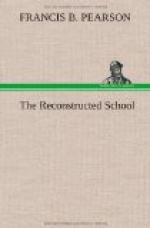This business man, unconsciously perhaps, puts his finger upon one of the weak places in our school procedure. He convicts us of stifling and repressing the imagination of our pupils. For it is a matter of common knowledge that every normal child is endowed with a vivid imagination when he enters school. No one will challenge this statement who has entered into the heart of childhood through the gateway of play. He has seen a rag doll invested with all the graces of a princess; he has seen empty spools take on all the attributes of the railway train; and he has seen the child’s world peopled with entities of which the unimaginative person cannot know. Children revel in the lore of fairyland, and in this realm nothing seems impossible to them. Their toys are the material which their imagination uses in building new and delightful worlds for them. If this imagination is unimpaired when they become grown-ups, these toys are called ideals, and these ideals are the material that enter into the lives of poets, artists, inventors, scientists, orators, statesmen, and reformers. If the child lacks this quality at the end of his school life, the school must be held responsible, at least in part, and so must face the charge of doing him an irreparable injury. It were better by far for the child to lose a leg or an arm somewhere along the school way than to lose his imagination. Better abandon the school altogether if it tends to quench the divine fire of imagination. Better still, devise some plan of so reconstructing the work of the school that we shall forever forestall the possibility of producing a generation of spiritual cripples.
The business man already quoted gives to the schools their cue. He shows the need of imagination in practical affairs and, by implication, shows that the school has been recreant to its opportunities in the way of stimulating this requisite quality. We must be quite aware that the men and women who have done things as well as those who are doing things have had or have imagination. Otherwise no achievements would be set down to their credit. It is the very acme of unwisdom to expect our pupils to accomplish things and then take from them the tools of their craft. Imagination is an indispensable tool, and the teacher assumes a grave responsibility who either destroys or blunts it. Unless the school promotes imagination it is not really a school, seeing that it omits from its plans and practices this basic quality. Too much emphasis cannot be laid upon this patent truth, nor can we deplore too earnestly the tendency of many teachers to strangle imagination.




